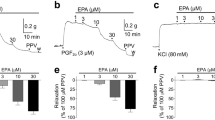Abstract
The vasomotor effects of 5-hydroxytryptamine (5-HT) on isolated equine basilar arteries were studied. 5-HT induced contractions of equine basilar arteries in a concentration-dependent manner, with a pEC50 value (with 95% confidence limits) of 7.35 (7.08–7.62). Similar results were obtained with endothelium-denuded basilar arteries. Contractions were not competitively inhibited by the 5-HT2 receptor antagonist ketanserin at low concentrations of 5-HT. Conversely, at high concentrations of 5-HT, contractions were inhibited by ketanserin in a concentration-dependent manner, with a pA 2 value of 8.91 (8.62–9.20). The 5-HT1 and 5-HT2 receptor antagonist methiothepin shifted the concentration-response curve of 5-HT downwards and to the right in a concentration-dependent manner. In the presence of 10-6 mol/L ketanserin, however, methiothepin antagonized 5-HT-induced contractions competitively with a pA 2 value of 7.95 (7.59–8.31). The 5-HT3 receptor antagonist MDL 72222 had no effect on 5-HT-induced contractions. The findings of this study indicate that 5-HT1 and 5-HT2 receptors are located in equine basilar arterial smooth muscle cells, and that stimulation of these receptors results in contraction.
Similar content being viewed by others
Abbreviations
- CR:
-
concentration ratio
- EC50 :
-
concentration producing 50% of the maximal response
- 5-HT:
-
5-hydroxytryptamine
- MDL 72222:
-
1αH,3α,5αH-tropan-3-yl-3,5-dichlorobenzoate
- pA 2 :
-
negative logarithm of the molar concentration of antagonist that produces a 2-fold rightward shift of the concentration-response curve
- pEC50 :
-
negative logarithm of EC50
- PGF2α :
-
prostaglandin F2α
References
Arunlakshana, O. and Schild, H.O., 1959. Some quantitative uses of drug antagonists. British Journal of Pharmacology, 14, 48–58
Chang, J.-Y, Hardebo, J.E., Owman, Ch., Sahlin, Ch. and Svendgaard, N.-Aa., 1987. Nerves containing serotonin, its interaction with noradrenaline, and characterization of serotonin receptors in cerebral arteries of monkey. Journal of Autonomic Pharmacology, 7, 317–329
Chang, J.-Y. and Owman, Ch., 1989. Cerebrovascular serotonergic receptors mediating vasoconstriction: further evidence for the existence of 5-HT2 receptors in rat and 5-HT1-like receptors in guinea-pig basilar arteries. Acta Physiological Scandinavica, 136, 59–67.
Chang, J.-Y., Hardebo, J.E. and Owman, Ch., 1988. Differential vasomotor action of noradrenaline, serotonin, and histamine in isolated basilar artery from rat and guinea-pig. Acta Physiologica Scandinavica, 132, 91–102
Connor, H.E. and Feniuk, W., 1989. Influence of the endothelium on contractile effects of 5-hydroxytryptamine and selective 5-HT agonists in canine basilar artery. British Journal of Pharmacology, 96, 170–178
Connor, H.E., Feniuk, W. and Humphrey, P.P.A., 1989. Characterization of 5-HT receptors mediating contraction of canine and primate basilar artery by use of GR43175, a selective 5-HT1-like receptor agonist. British Journal of Pharmacology, 96, 379–387
Deckert, V. and Angus, J.A., 1992. Evidence that 5-HT2 receptors predominantly mediate the contraction of the rat basilar artery to 5-hydroxytryptamine. European Journal of Pharmacology, 221, 17–25
Frenken, M., 1989. Evidence for two populations of 5-hydroxytryptamine receptors in dog basilar artery. Jounal of Pharmacology and Experimental Therapeutics, 250, 379–387
Gaw, A.J., Wadsworth, R.M. and Humphrey, P.P.A., 1990. Pharmacological characterization of postjunctional 5-HT receptors in cerebral arteries from the sheep. European Journal of Pharmacology, 179, 35–44
Hoyer, D., Clarke, D.E., Fozard, J.R., Hartig, P.R., Martin, G.R., Mylecharane, E.J., Saxena, P.R. and Humphrey, P.P.A., 1994. International union of pharmacology classification of receptors for 5-hydroxytryptamine (serotonin). Pharmacological Reviews, 46, 157–203
Meyers, K. and Wardrop, K.J., 1991. Platelets and coagulation. In: C.E.Cornelius, R.R.Marshak and E.C.Melby (eds), Advances in Veterinary Science and Comparative Medicine, vol. 36 (Academic Press, San Diego), 87–150
Miyamoto, A., Sakota, T. and Nishio, A., 1994. Characterization of 5-hydroxytryptamine receptors on the isolated pig basilar artery by functional and radioligand binding studies. Japanese Journal of Pharmacology, 65, 265–273
Miyamoto, A., Matsumoto, M. and Nishio, A., 1995. Pharmacological detection of an integrity of endothelium in pig, cattle and horse basilar arteries in vitro. Memoirs of the Faculty of Agriculture, Kagoshima University, 31, 63–68
Mylecharane, E.J., 1991. 5-HT2 receptor antagonists and migraine therapy. Journal of Neurology, 238, s45-s52
Obi, T., Kabeyama, A. and Nishio, A., 1994. Equine coronary artery responds to 5-hydroxytryptamine with relaxation in vitro. Journal of Veterinary Pharmacology and Therapeutics, 17, 218–225
Parsons, A.A., Whalley, E.T., Feniuk, W., Connor, H.E. and Humphrey, P.P.A., 1989. 5-HT1-like receptors mediate 5-hydroxytryptamine-induced contraction of human isolated basilar artery. British Journal of Pharmacology, 96, 434–449
Peroutka, S.J., 1993. 5-Hydroxytryptamine receptor subtypes and the pharmacology of migraine. Neurology, 43 (Suppl. 3), s34-s38
Perren, M.J., Feniuk, W. and Humphrey, P.P.A., 1991. Vascular 5-HT1-like receptors that mediate contraction of the dog isolated saphenous vein and carotid arterial vasoconstriction in anaesthetized dogs are not of the 5-HT1A or 5-HT1D subtype. British Journal of Pharmacology, 102, 191–197
Seager, J.M., Clark, A.H. and Garland, C.J., 1992. Endothelium-dependent contractile responses to 5-hydroxytryptamine in the rabbit basilar artery. British Journal of Pharmacology, 105, 424–428
Trezise, D.J., Drew, G.M. and Weston, A.H., 1992. Analysis of the depressant effect of the endothelium on contractions of rabbit isolated basilar artery to 5-hydroxytryptamine. British Journal of Pharmacology, 106, 587–592
Wallenstein, S., Zucker, C.L. and Fleiss, J.L., 1980. Some statistical methods useful in circulation research. Circulation Research, 47, 1–9
Wilkins, R.J., 1980. Cerebral Arterial Spasm, (Williams & Wilkins, Baltimore)
Zifa, E. and Fillon, G., 1992. 5-Hydroxytryptamine receptors. Pharmacological Reviews, 44, 401–458
Author information
Authors and Affiliations
Rights and permissions
About this article
Cite this article
Miyamoto, A., Obi, T. & Nishio, A. The vasomotor effects of 5-hydroxytryptamine on equine basilar arteries In vitro . Veterinary Research Communications 20, 61–70 (1996). https://doi.org/10.1007/BF00346578
Accepted:
Issue Date:
DOI: https://doi.org/10.1007/BF00346578




